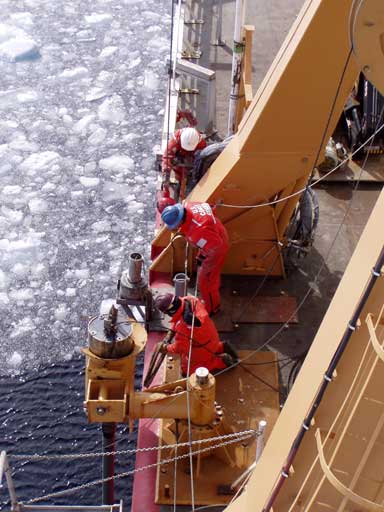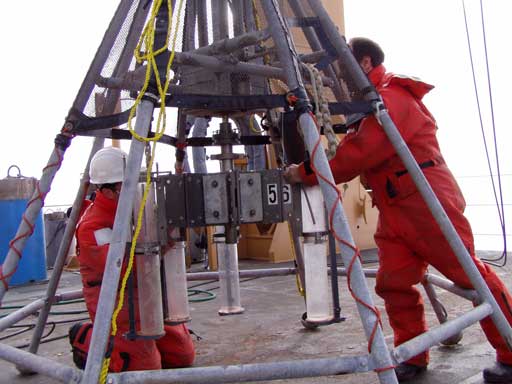( Log In ) Log In is for TREC Teachers & Researchers only
  |
| Steve_Marshall |
 Jun 24 2005, 05:42 AM Jun 24 2005, 05:42 AM
Post
#1
|
 TREC Teacher    Group: TREC Team Posts: 78 Joined: 27-April 05 Member No.: 12 |
Tuesday 6/21/05
A FULL DAY FOR THE LONGEST DAY Today is the summer solstice, the “longest day” for most people in the northern hemisphere, but that doesn’t really apply here since the sun has been up 24 hours a day ever since we got here. The only thing I guess that would be special within the Arctic Circle on the summer solstice is that it marks the highest point above the horizon that the sun will reach. From now on, the sun will begin its slow descent towards the horizon until eventually sometime in the fall, it will be total darkness for 24 hours. I think I enjoy 24 hours of light much more than I would 24 hours of darkness. I haven’t been reporting much on weather conditions throughout most of my journal entries, because it hasn’t changed that much. It’s mostly been bright sunshine with temperatures somewhere in the 30s F. Today around noon was the first time we had encountered a long period of fog, but it still didn’t slow down our operations. Piston Core #3 Today we deployed another piston core, another multi-core, and conducted another plankton tow. Since I have described most of these processes in detail with earlier entries, I’ll just relay anything new or noteworthy about the procedures conducted today. As for the piston core, it was our most successful to date. Although the starting core length was shorter than previous ones, 15 meters, it was almost completely filled with sediment, so this actually yielded more sediment than the second core in which only 11 meters of the total length of 22 meters was filled. Getting Ready to Lift  The crane line (line with red weight and hook at the end), shown next to the blue helmet of the crew member pictured in the middle, is brought closer to be fastened to the brown strap held by the crew member pictured in the foreground. This allows the core to be lifted out of the water The Lifting Begins  Here you can notice the line connecting the core to the crane has shifted towards the middle, so the lifting of the core can now begin Getting Closer to the Surface  Notice the large weight at the top of the core is rotating in its holder as the core is lifted. On the first core that was bent, this rotation did not occur, indicating that either the holder was stuck, causing the bending, or the core was already damaged, so there wasn’t any pressure to cause the holder to rotate. At any rate, it’s working fine here, so that’s a good sign all will be well. Looks Good  Having been lifted fully out of the water, the core appears to be perfectly straight…No problems with this one! Another Good Sign  The appearance of mud all along the length of the core indicates the entire core made it below the seafloor. Multi-Core #2 Our second multi-core was a little less successful than the first in terms of the amount of sediment in the core tubes (about 1/3 of the total), but it was still useful, and contained a fair amount of organisms. For this multi-core, I helped out mostly by transporting the individual tubes from the multi-corer to the storage rack and fastening them there. Getting the Mulit-Corer Ready  Guillaume St-Onge (left) and Greg Cutter (right) attach the core tubes to the multi-corer. Next Step  Once attached, the core tubes must be opened both at the top and bottom to allow sediment to be drawn into it. Once the core starts to come up, the “shovel leg” (the part Guillaume is holding on to) will swing down under the bottom of the core tube to hold the collected sediment in the core tube. Coming Home  A picture of the multi-corer getting close to the surface Taking Part in the Action  A picture of me taking a break from transporting the core tubes from the corer to their storage rack There’s Life in Those Cores!  The white, curved-shape object just below the sediment surface is some type of burrowing organism. Another thing to note here is the distinct color change from the rust-colored top to the steel-gray bottom half. This is the type of change that is studied and interpreted. An Added Bonus  In addition to the sediment samples, a Niskin bottle was attached to the multi-corer to get a sample of the water near the seafloor. Here, Guillaume St-Onge transfers the water to a sample container. Plankton Tow and Other Things Another plankton tow was also conducted. I never expected there to be so much plankton in the middle of the Arctic Ocean, but each tow added numerous copepods, krill, foraminifera, etc to the already rich collections Joseph Ortiz and Leonid Polyak would be studying as part of their research. After the plankton tow, I went into the lab to observe Guillaume St-Onge and Christine Theriault doing their reflectance studies on the multi-core samples we had obtained earlier. The picture-of-the-day from this study was the worm that was spotted in the core they were working with. More Life than You Might Think  It must be a chilly lifestyle, but the Arctic Ocean subsurface is home to a purple-colored worm shown here in the middle of the picture near the top of the core sample. Preparing the Sample  Guillaume smoothes out the core sample in preparation of his reflectance study. Working Together  Christine Theriault works along with St-Onge in studying the core sample The comic relief of the day was trying to cut the gravity (trigger) core from the previous piston core operation. Wanting to cut the core while it is vertical to avoid mixing of the sediment in the core, Dennis Darby had to be at an odd angle to the core while laying on a platform at the top of the core. Stefanie Brachfeld and myself had the “honor” of being underneath Darby as he attempted to cut the core. Because of the odd angle, it was only after two broken pipe cutter blades and using a power saw as a last resort, that the core was finally cut. This process caused a steady rain of seawater, mud, and pipe shavings to fall on Stefanie and myself. Ya can’t beat that for fun at 11:00 at “night” in the Arctic!:) Where’s the Umbrella??  A steady “rain” of water, mud, and pipe shavings falls on Stefanie Brachfeld and myself as Dennis Darby (not pictured, but above us) cuts the top of the gravity core (the core that triggers the release of the large weight that drives the piston core into the seafloor). This was more fun than humans should be allowed to have Anyway, we finally wrapped things up around midnight on the “longest day,” so it was appropriate to have so much to fill it, and equally appropriate that as we ended the “day,” the fog cleared and the sun shown brightly again. |
  |
1 User(s) are reading this topic (1 Guests and 0 Anonymous Users)
0 Members:

|
NSF Acknowledgment & Disclaimer | Time is now: 15th November 2024 - 05:19 AM |
Invision Power Board
v2.1.7 © 2024 IPS, Inc.








